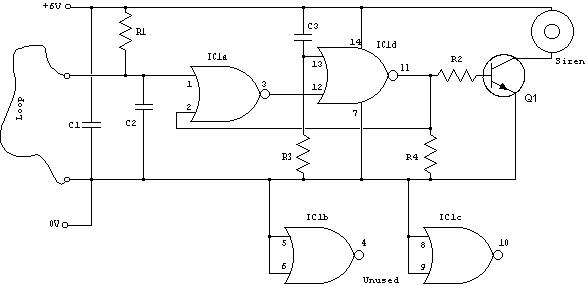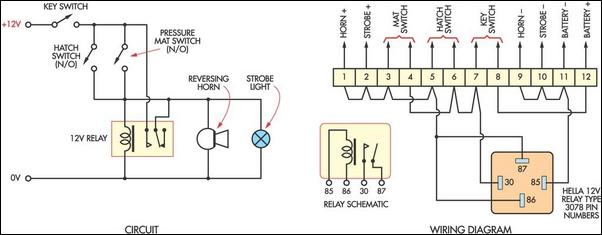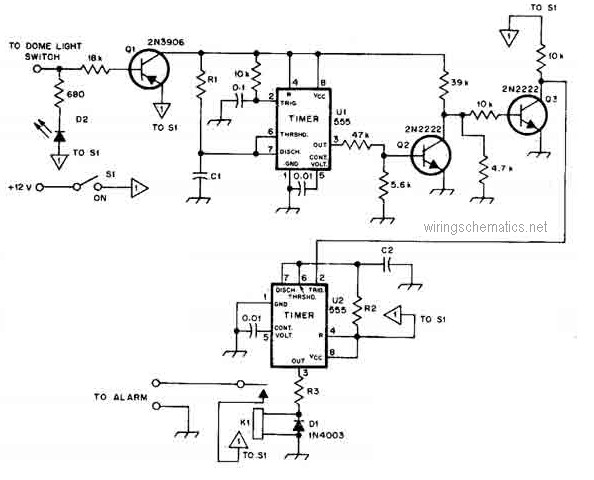
Boat alarm

Removing R1 or R2 from the circuit allows a potential thief to break a hidden wire that connects R1 to +12 V and R2 to ground. This action activates the alarm for approximately five minutes.
The circuit in question is designed as a security mechanism, utilizing resistors R1 and R2 to maintain a stable connection to a power source and ground. In a typical configuration, R1 is connected to a +12 V supply, while R2 is grounded. The removal of either resistor disrupts the circuit's integrity, effectively signaling an unauthorized tampering attempt.
When R1 or R2 is removed, the circuit detects the change in resistance and triggers an alarm system. This alarm is programmed to activate for a duration of about five minutes, serving as a deterrent to potential intruders. The design relies on the principle of voltage division and current flow, where the resistors play a crucial role in maintaining the circuit's normal operation.
In practical applications, this circuit can be integrated into various security systems, including home alarm systems, vehicle anti-theft devices, or any application requiring a hidden security feature. The alarm's five-minute activation period provides sufficient time for the property owner or security personnel to respond to the breach, ensuring a proactive approach to security management.
This schematic can be further enhanced with additional features such as a timer reset mechanism, a notification system that alerts the owner via mobile or SMS, or integration with surveillance cameras for visual confirmation of the alarm trigger. The overall effectiveness of this circuit relies on its simplicity, reliability, and the element of surprise it offers against potential threats.Removing R1 or R2 from the circuit the potential thief breaks a hidden wire that connects R1 to +12 V and R2 to ground) Activates the alarm for about five minutes.
The circuit in question is designed as a security mechanism, utilizing resistors R1 and R2 to maintain a stable connection to a power source and ground. In a typical configuration, R1 is connected to a +12 V supply, while R2 is grounded. The removal of either resistor disrupts the circuit's integrity, effectively signaling an unauthorized tampering attempt.
When R1 or R2 is removed, the circuit detects the change in resistance and triggers an alarm system. This alarm is programmed to activate for a duration of about five minutes, serving as a deterrent to potential intruders. The design relies on the principle of voltage division and current flow, where the resistors play a crucial role in maintaining the circuit's normal operation.
In practical applications, this circuit can be integrated into various security systems, including home alarm systems, vehicle anti-theft devices, or any application requiring a hidden security feature. The alarm's five-minute activation period provides sufficient time for the property owner or security personnel to respond to the breach, ensuring a proactive approach to security management.
This schematic can be further enhanced with additional features such as a timer reset mechanism, a notification system that alerts the owner via mobile or SMS, or integration with surveillance cameras for visual confirmation of the alarm trigger. The overall effectiveness of this circuit relies on its simplicity, reliability, and the element of surprise it offers against potential threats.Removing R1 or R2 from the circuit the potential thief breaks a hidden wire that connects R1 to +12 V and R2 to ground) Activates the alarm for about five minutes.





